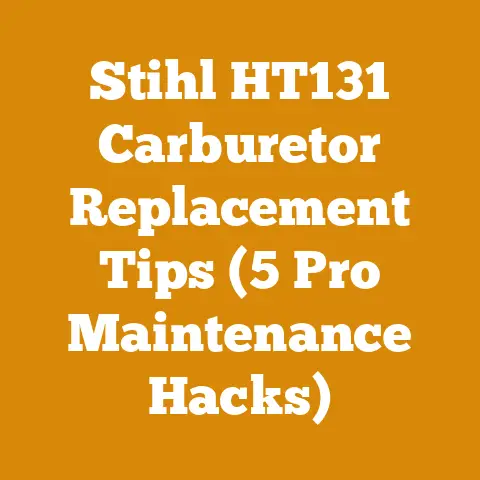2002 Polaris Sportsman 700 Wood Hauling (5 Expert Tips)
Versatility is the name of the game when you’re talking about a workhorse like the 2002 Polaris Sportsman 700. I’ve spent countless hours in the woods, relying on this ATV for everything from scouting trails to hauling impressive loads of firewood. The Sportsman 700 is more than just an ATV; it’s a partner in getting the job done. Over the years, I’ve picked up a few tricks to maximize its capabilities for wood hauling.
2002 Polaris Sportsman 700 Wood Hauling: 5 Expert Tips
Tip #1: Optimizing Your Sportsman 700 for Heavy Loads
The stock configuration of the 2002 Polaris Sportsman 700 is decent, but it needs a little help to truly shine when hauling heavy loads of wood. I’ve found a few key upgrades make a world of difference.
Suspension Upgrades
The first area I always address is the suspension. The original springs can sag under the weight of a fully loaded trailer or cargo bed. I recommend upgrading to heavier-duty springs, especially in the rear.
- Types of Springs: Consider progressive rate springs. These offer a softer ride when unloaded but stiffen up as the load increases. This gives you a comfortable ride while still handling heavy weight.
- Installation: Replacing the springs is a relatively straightforward process, often requiring just basic tools like spring compressors and wrenches. I’ve done it myself several times, and there are plenty of online tutorials if you’re unsure.
- Impact: Upgraded springs will reduce bottoming out, improve handling, and increase the overall stability of your Sportsman 700 when hauling wood. Expect to spend around $150-$300 for a good set of rear springs.
Tire Selection
Tires are another crucial factor. The stock tires are often not aggressive enough for challenging terrain or heavy loads. I prefer tires with a deeper tread pattern and a higher ply rating.
- Tread Pattern: Look for tires designed for mud and snow. These usually have a more aggressive tread pattern that provides better traction in loose soil and on wet logs.
- Ply Rating: A higher ply rating indicates a stronger tire that can handle more weight and resist punctures. I recommend at least a 6-ply tire for heavy-duty wood hauling.
- Size Considerations: While you can go with larger tires, be mindful of clearance issues. Too large of a tire can rub against the fenders or reduce power. I generally stick to the stock tire size or go slightly larger (e.g., from 25″ to 26″) to maintain optimal performance.
- Example: I personally use Maxxis Bighorn tires on my Sportsman 700. They provide excellent traction and durability in a variety of conditions. A set of four tires will cost around $400-$600.
Cargo Bed and Trailer Selection
How you carry the wood is just as important as the ATV itself. I use a combination of a cargo bed rack and a small utility trailer.
- Cargo Bed Rack: A cargo bed rack increases the amount of wood you can carry directly on the ATV. Look for a rack that is sturdy and well-built, with a good weight capacity.
- Utility Trailer: A small utility trailer is essential for hauling larger loads. I recommend a trailer with a tilting bed for easy loading and unloading.
- Weight Distribution: When loading the cargo bed and trailer, be sure to distribute the weight evenly. Place heavier logs towards the front of the trailer to improve stability and reduce the risk of tipping.
- Securing the Load: Always secure the load with straps or chains. This will prevent the wood from shifting during transport and ensure a safe ride. I prefer ratchet straps for their ease of use and adjustability.
- Personal Experience: I once tried to haul too much wood in the cargo bed without a rack. The load shifted, and the ATV became unstable. I learned my lesson and invested in a good cargo bed rack. It’s made a huge difference in my hauling capacity and safety.
Takeaway: Upgrading the suspension, tires, and cargo carrying options can significantly improve the hauling capacity and stability of your 2002 Polaris Sportsman 700.
Tip #2: Mastering Safe Loading and Weight Distribution
Proper loading and weight distribution are critical for safe and efficient wood hauling. An overloaded or poorly balanced load can lead to accidents and damage to your ATV. I’ve learned this the hard way on more than one occasion.
Understanding Weight Limits
The 2002 Polaris Sportsman 700 has a specified weight limit, which includes the rider, cargo, and any accessories. Consult your owner’s manual for the exact weight limit. Exceeding this limit can damage the ATV’s suspension, drivetrain, and frame.
- Calculating Load Weight: It’s important to know how much your wood weighs. Green wood is much heavier than seasoned wood. A cord of green hardwood can weigh up to 5,000 pounds, while a cord of seasoned hardwood may weigh around 3,000 pounds.
- Estimating Load Size: I typically estimate the weight of my loads based on the volume of wood I’m hauling. A standard cargo bed rack can hold about 1/4 of a cord of wood, while a small utility trailer can hold 1/2 to 1 cord.
- Staying Within Limits: I always err on the side of caution and avoid overloading my ATV. It’s better to make multiple trips than to risk an accident or damage to the machine.
Optimizing Weight Distribution
Proper weight distribution is essential for maintaining stability and control. The goal is to keep the center of gravity as low and as centered as possible.
- Loading Order: When loading the cargo bed and trailer, start by placing the heaviest logs at the bottom and towards the front. This will help to lower the center of gravity and improve stability.
- Balancing the Load: Make sure to distribute the weight evenly from side to side. An unbalanced load can cause the ATV to lean to one side, making it difficult to steer and increasing the risk of tipping.
- Securing the Load: Use straps or chains to secure the load tightly. This will prevent the wood from shifting during transport and maintain the weight distribution.
- Personal Experience: I once loaded a trailer with too much weight in the back. As I started up a hill, the front wheels lifted off the ground, and I lost steering control. I was lucky to avoid an accident, but it was a close call. Now, I always pay close attention to weight distribution.
Practical Loading Techniques
Here are a few practical tips for loading wood safely and efficiently:
- Use a Loading Ramp: A loading ramp can make it much easier to load heavy logs into the cargo bed or trailer.
- Work with a Partner: If possible, work with a partner to load the wood. This will make the job easier and safer.
- Take Breaks: Loading wood can be physically demanding. Take breaks as needed to avoid fatigue.
- Proper Lifting Techniques: Use proper lifting techniques to avoid back injuries. Bend your knees, keep your back straight, and lift with your legs.
- Always Check Your Load: Before starting to haul, double-check that the load is properly secured and the weight is evenly distributed.
Takeaway: Understanding weight limits and mastering proper loading techniques are essential for safe and efficient wood hauling.
The 2002 Polaris Sportsman 700 is a capable machine, but it’s not invincible. Navigating challenging terrain with a heavy load of wood requires skill, experience, and a healthy dose of caution. I’ve learned a lot about this over the years, sometimes through trial and error.
Understanding Your ATV’s Capabilities
The Sportsman 700 has features like four-wheel drive (4WD) and independent rear suspension (IRS) that can be a big help in challenging terrain. However, it’s important to understand the limits of these features.
- 4WD Engagement: The 4WD system provides added traction in slippery or uneven terrain. However, it’s not a substitute for good driving skills. Engage 4WD before you need it, rather than waiting until you’re stuck.
- IRS Benefits: The IRS provides a smoother ride and better ground clearance than a solid axle suspension. This can be helpful when navigating obstacles like rocks and logs.
- Ground Clearance: Be aware of the ATV’s ground clearance. Avoid driving over obstacles that are too high, as this can damage the undercarriage. I’ve dented my share of skid plates learning this lesson.
- Engine Braking: The Sportsman 700 has engine braking, which can help to control your speed on steep descents. Use engine braking in conjunction with the brakes to maintain control.
Mastering Driving Techniques
Driving in challenging terrain requires a different set of skills than driving on smooth roads. Here are a few techniques that I’ve found helpful:
- Low Gear: Use low gear when climbing steep hills or navigating rough terrain. This will provide more power and control.
- Smooth Throttle Control: Avoid jerky throttle movements. Smooth, consistent throttle control is essential for maintaining traction.
- Look Ahead: Scan the trail ahead for obstacles and plan your route accordingly.
- Weight Shifting: Shift your weight to maintain traction and stability. Lean forward when climbing hills and lean back when descending.
- Avoid Sudden Movements: Avoid sudden turns or braking. These can upset the balance of the ATV and lead to an accident.
Different types of terrain present different challenges. Here are a few tips for navigating specific terrain types:
- Hills: When climbing hills, approach at a slight angle to avoid losing traction. Maintain a steady throttle and avoid stopping in the middle of the hill.
- Mud: When driving through mud, maintain momentum and avoid spinning the tires. If you get stuck, try rocking the ATV back and forth to gain traction.
- Rocks: When driving over rocks, choose your path carefully to avoid damaging the tires or undercarriage. Drive slowly and deliberately.
- Water Crossings: Before attempting a water crossing, check the depth of the water and the condition of the bottom. Avoid crossing water that is too deep or has a strong current.
Recovery Techniques
Even with the best driving skills, you may still get stuck occasionally. Here are a few techniques for recovering a stuck ATV:
- Winching: A winch is an essential tool for recovering a stuck ATV. Attach the winch cable to a secure anchor point and slowly winch the ATV out of the mud or snow.
- Towing: If you don’t have a winch, you can try towing the ATV out with another vehicle. Use a tow strap or chain and make sure to attach it to a strong point on both vehicles.
- Tire Chains: Tire chains can provide added traction in snow or ice. Install the chains on the rear tires for maximum effectiveness.
- Personal Experience: I once got my Sportsman 700 stuck in a deep mud hole. I tried everything to get it out, but nothing worked. Finally, I had to call a friend with a winch to pull me out. Since then, I’ve always carried a winch and a tow strap with me.
Takeaway: Navigating challenging terrain with a loaded ATV requires skill, experience, and a healthy dose of caution. Understanding your ATV’s capabilities, mastering driving techniques, and knowing how to recover a stuck ATV are essential for safe and efficient wood hauling.
Tip #4: Maintaining Your 2002 Sportsman 700 for Reliability
Regular maintenance is essential for keeping your 2002 Polaris Sportsman 700 running reliably, especially when using it for demanding tasks like wood hauling. Neglecting maintenance can lead to breakdowns and costly repairs. I’ve learned this lesson the hard way, often at the most inconvenient times.
Regular Maintenance Schedule
I follow a regular maintenance schedule to keep my Sportsman 700 in top condition. This schedule includes:
- Oil Changes: Change the engine oil and filter every 25 hours of use or at least once a year. I use a high-quality synthetic oil designed for ATVs.
- Air Filter Cleaning: Clean the air filter every 10 hours of use or more frequently in dusty conditions. A dirty air filter can reduce engine performance and damage the engine.
- Spark Plug Replacement: Replace the spark plug every 100 hours of use. A worn spark plug can cause misfires and reduce engine performance.
- Grease Fittings: Grease all of the grease fittings every 25 hours of use. This will help to lubricate the suspension and steering components and prevent wear.
- Tire Pressure: Check the tire pressure before each ride. Proper tire pressure is essential for handling and fuel economy.
- Coolant Level: Check the coolant level regularly. Low coolant can cause the engine to overheat.
- Brake Inspection: Inspect the brakes regularly for wear. Replace the brake pads or shoes as needed.
- Chain Lubrication: Lubricate the drive chain regularly. A dry chain can wear out quickly.
- Battery Maintenance: Keep the battery terminals clean and tight. If the ATV is not used for extended periods, use a battery tender to keep the battery charged.
Inspecting for Wear and Damage
In addition to regular maintenance, I also inspect the ATV regularly for wear and damage. This includes:
- Tires: Check the tires for cuts, punctures, and uneven wear. Replace the tires as needed.
- Suspension: Inspect the suspension components for damage or wear. Replace any worn or damaged parts.
- Brakes: Check the brake lines for leaks and the brake rotors for damage. Replace any worn or damaged parts.
- Frame: Inspect the frame for cracks or damage. Have any cracks repaired by a qualified welder.
- Lights: Check the lights to make sure they are working properly. Replace any burned-out bulbs.
- Cables and Hoses: Inspect the cables and hoses for cracks or leaks. Replace any worn or damaged parts.
Essential Tools and Supplies
Having the right tools and supplies on hand can make maintenance and repairs much easier. Here are a few essential items that I keep in my garage:
- Wrenches and Sockets: A good set of wrenches and sockets is essential for any maintenance or repair job.
- Screwdrivers: A variety of screwdrivers, including Phillips and flathead, is also essential.
- Pliers: A set of pliers, including needle-nose and slip-joint, is useful for a variety of tasks.
- Grease Gun: A grease gun is needed to lubricate the grease fittings.
- Oil Filter Wrench: An oil filter wrench is needed to remove and install the oil filter.
- Spark Plug Wrench: A spark plug wrench is needed to remove and install the spark plug.
- Tire Pressure Gauge: A tire pressure gauge is needed to check the tire pressure.
- Multimeter: A multimeter is useful for diagnosing electrical problems.
- Oil, Filters, and Spark Plugs: Keep a supply of oil, filters, and spark plugs on hand so you can perform maintenance when needed.
- Grease: Keep a supply of grease on hand for lubricating the grease fittings.
- Spare Parts: Keep a supply of common spare parts, such as brake pads, belts, and fuses, on hand so you can make repairs quickly.
Troubleshooting Common Problems
Even with regular maintenance, problems can still occur. Here are a few tips for troubleshooting common problems:
- Engine Won’t Start: Check the fuel level, spark plug, and battery.
- Engine Runs Poorly: Check the air filter, spark plug, and fuel system.
- Brakes Don’t Work: Check the brake fluid level and brake pads.
- ATV Overheats: Check the coolant level and radiator.
- Electrical Problems: Check the fuses and wiring.
- Personal Experience: I once had my Sportsman 700 overheat while hauling wood. I checked the coolant level and found that it was low. I added coolant, and the problem was solved. Now, I always check the coolant level before each ride.
Takeaway: Regular maintenance is essential for keeping your 2002 Polaris Sportsman 700 running reliably. By following a regular maintenance schedule, inspecting for wear and damage, and keeping the right tools and supplies on hand, you can minimize breakdowns and keep your ATV in top condition.
Tip #5: Safety First: Gear and Practices for Wood Hauling
Safety should always be your top priority when hauling wood with your 2002 Polaris Sportsman 700. Accidents can happen quickly, and the consequences can be serious. I’ve witnessed firsthand the importance of proper safety gear and practices.
Essential Safety Gear
Wearing the right safety gear can significantly reduce the risk of injury in the event of an accident. Here’s a list of essential safety gear that I always wear when hauling wood:
- Helmet: A helmet is the most important piece of safety gear. Choose a helmet that is DOT-approved and fits properly. I prefer a full-face helmet for maximum protection.
- Eye Protection: Eye protection, such as goggles or a face shield, is essential for protecting your eyes from dust, debris, and branches.
- Gloves: Gloves protect your hands from cuts, scrapes, and blisters. Choose gloves that are durable and provide a good grip. I prefer leather gloves for their durability and comfort.
- Long Sleeves and Pants: Long sleeves and pants protect your skin from scratches, cuts, and insect bites.
- Boots: Boots provide ankle support and protect your feet from injury. Choose boots that are sturdy and have good traction. I prefer steel-toed boots for added protection.
- Hearing Protection: Hearing protection, such as earplugs or earmuffs, can help to protect your hearing from the noise of the engine.
- Reflective Clothing: Wear reflective clothing, especially when working in low-light conditions. This will make you more visible to other people.
Safe Operating Practices
In addition to wearing the right safety gear, it’s also important to follow safe operating practices. Here are a few tips:
- Read the Owner’s Manual: Before operating the ATV, read the owner’s manual carefully. This will familiarize you with the ATV’s controls and safety features.
- Take a Safety Course: Consider taking an ATV safety course. This will teach you safe operating techniques and emergency procedures.
- Inspect the ATV Before Each Ride: Before each ride, inspect the ATV for any problems. Check the tires, brakes, lights, and steering.
- Never Ride Under the Influence: Never ride under the influence of alcohol or drugs.
- Ride at a Safe Speed: Ride at a safe speed for the conditions. Avoid excessive speed, especially on rough terrain.
- Be Aware of Your Surroundings: Be aware of your surroundings and watch out for obstacles, other vehicles, and pedestrians.
- Avoid Riding on Paved Roads: Avoid riding on paved roads whenever possible. ATVs are not designed for use on paved roads and can be unstable at high speeds.
- Never Carry Passengers: Never carry passengers on an ATV unless it is designed to carry passengers.
- Supervise Young Riders: Supervise young riders closely. Make sure they are wearing the proper safety gear and following safe operating practices.
- Stay on Marked Trails: Stay on marked trails whenever possible. This will help to protect the environment and avoid accidents.
- Let Someone Know Your Plans: Before heading out, let someone know your plans and expected return time.
- Carry a First-Aid Kit: Carry a first-aid kit with you in case of an accident.
- Carry a Cell Phone or Radio: Carry a cell phone or radio so you can call for help if needed.
- Personal Experience: I once witnessed an ATV accident where a rider was seriously injured because he wasn’t wearing a helmet. Since then, I’ve always made sure to wear a helmet and encourage others to do the same.
Specific Safety Considerations for Wood Hauling
Wood hauling presents some unique safety challenges. Here are a few specific safety considerations:
- Secure the Load Properly: Make sure the load is properly secured with straps or chains. This will prevent the wood from shifting during transport and causing an accident.
- Be Careful When Loading and Unloading: Be careful when loading and unloading wood. Use proper lifting techniques to avoid back injuries.
- Watch Out for Low-Hanging Branches: Watch out for low-hanging branches when driving through the woods. These can be a hazard to your eyes and face.
- Be Aware of the Terrain: Be aware of the terrain and watch out for obstacles such as rocks, logs, and holes.
- Avoid Overloading the ATV: Avoid overloading the ATV. Overloading can make the ATV unstable and difficult to control.
- Be Prepared for Emergencies: Be prepared for emergencies. Carry a first-aid kit, a cell phone or radio, and a winch or tow strap.
Takeaway: Safety should always be your top priority when hauling wood with your 2002 Polaris Sportsman 700. By wearing the right safety gear, following safe operating practices, and being aware of the specific safety considerations for wood hauling, you can minimize the risk of accidents and injuries.






